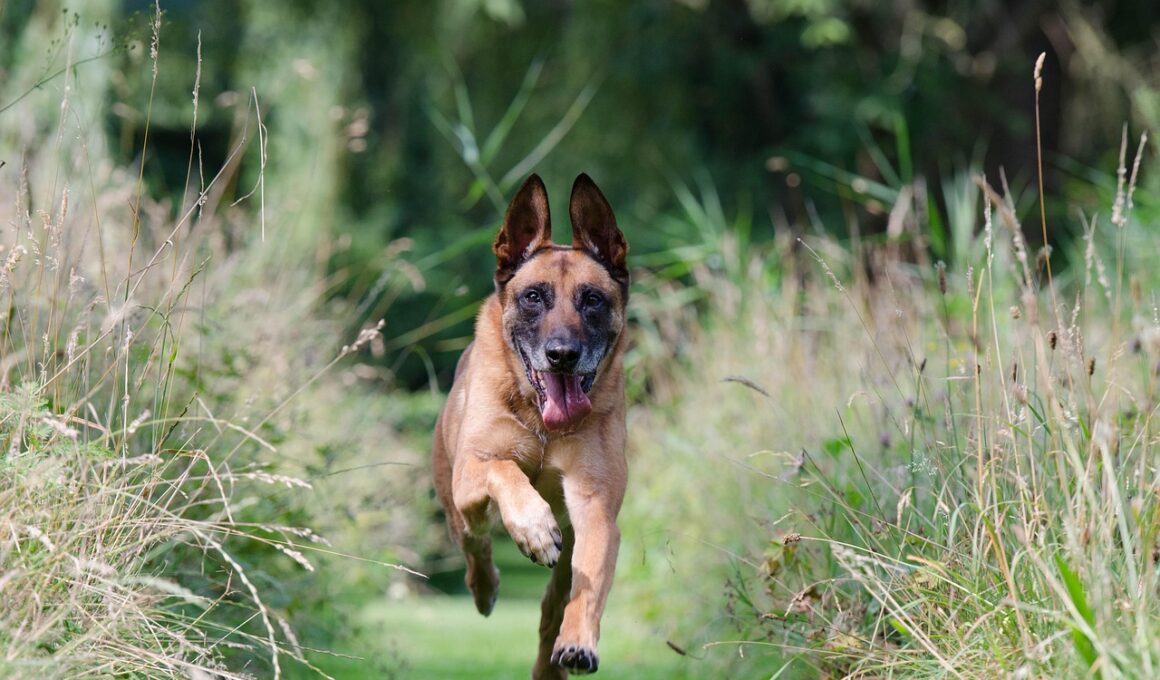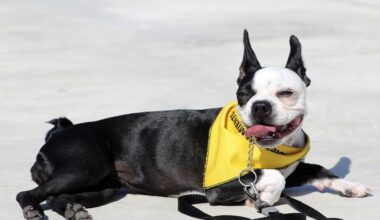Recall Training for Rescue Dogs: Special Considerations
Training rescue dogs to recall is both rewarding and challenging. These dogs may have experienced trauma or neglect, impacting their behavior and trust. It is crucial to approach training with a sense of empathy and patience. Establish a safe and positive environment where the dog feels secure. Start with short distances in familiar locations, using positive reinforcement. Reward the dog with treats or praise when they come when called. Consistency and repetition will be vital in reinforcing the desired behavior. Gradually increase the distance and distractions, ensuring to maintain a positive atmosphere. Incorporate a reliable recall command consistently. Utilize the dog’s name and a specific command, like
Come!
to help them understand what is expected. During training sessions, it is essential to remain calm and cheerful. Avoid using punitive measures, which can lead to fear or anxiety. Recognizing the dog’s body language is crucial; it helps to interpret emotions and build trust. Ensure their environment is free from sudden noises or distractions that can unsettle them. This patience-built foundation is the cornerstone for a reliable recall. Integrate games such as hide and seek to create a fun training atmosphere. Use a long line during off-leash training to encourage freedom while maintaining control. The goal is to foster a loving bond that encourages obedience and a strong connection. Each training step should be progressive, adjusting to the dog’s comfort level. Keep sessions short and engaging to prevent boredom or stress. Celebrate small victories to maintain motivation and enthusiasm. Overall, the key lies in understanding the unique history of rescue dogs and adapting your training techniques accordingly.
It’s important to tailor recall sessions according to the specific needs of rescue dogs. Assess their background to understand potential triggers, such as past abuse or neglect. Some rescue dogs may be fearful of people or situations, which can affect their responsiveness. Addressing these fears requires a careful approach. Introduce recall techniques in a controlled manner, ensuring they associate coming to you with positive experiences. Use high-value treats that excite them, like chicken or liver. Gradually expose them to increasing distractions in safe environments. Gradually increase the distance and challenges while reinforcing the recall command. Consider utilizing special training tools, like whistles, which can be beneficial in certain scenarios. Whistles can be much clearer and further-reaching than verbal commands. For enhanced training, practice recall during walks and outings, reinforcing commands regularly. Establish a routine that fosters reliability. Always remember to show patience and understanding. The journey might be longer, but consistency will lead to success. By embracing these techniques, you’ll greatly increase the likelihood of a successful recall, fostering both the dog’s confidence and your bond.
Incorporating playtime into your recall training can make the process more enjoyable for both you and your rescue dog. Use toys or games to create enthusiasm around coming to you. Once the dog begins to associate recall with fun activities, chances improve for a successful response. Build excitement during the training by engaging with interactive toys. Make the recall exercise feel more like a game than a chore. You want your dog to see coming when called as a joyful experience, not something negative. Positive reinforcement should be immediate. This means rewarding them the moment they return to you, so they clearly associate the action with the reward. Use variety; if they enjoy running, make it a fun sprint back to you. Showcase your happiness to reinforce that coming to you brings joy. This also shows that being near you is safe and fulfilling. Remember to gradually reduce treats as the dog masters the skill, but continue verbal praise and interaction to maintain enthusiasm. As the bond strengthens, your dog will learn to trust your commands, showcasing their recall skills reliably.
Dealing with Challenges
While training may progress, expect challenges, especially in busy environments. Distractions can hinder recall ability. This may include other dogs, people, or noises. During these situations, remain proactive and patient. Start recalls in quieter locations before transitioning to more chaotic settings. Ensure you’re prepared to adjust your methods if the dog is struggling. Consider using a long lead, allowing them some freedom while maintaining control. If they often ignore commands, identify whether the environment is too stimulating, creating a stress response. Use techniques that limit distractions, such as practicing in less crowded areas at first. Remember, training is a journey, not a race. Every dog learns at their own pace. Consistency is critical; reinforce commands often, especially until the dog is reliably responding. Provide gentle correction if expectations aren’t met without scolding. Patience will remind both of you that breakthrough moments will happen, even if they take time. Compliment their efforts continually during challenging sessions to keep their spirits high. Celebrate their successes often, regardless of how small, creating a dynamic learning atmosphere!
Understanding that recall training for rescue dogs may take extra time and effort is essential. However, that effort is often worth the long-term benefits of a strong bond and reliable behavior. Focus on building a relationship of trust; it is a fundamental aspect of successful training. Always strive to create a loving environment where the dog feels safe. For some dogs, increased socialization may help build confidence and improve recall abilities. Engage with other dogs or supportive environments to facilitate this process. As you conduct training, assess and adjust your techniques based on your dog’s system needs. Research potential behavioral issues like separation anxiety or fear-based reactions. Keeping a diary to track progress can help identify specific areas for improvement and celebrate achievements. You may also seek guidance from professionals familiar with rescue dogs if challenges seem overwhelming. Remember, you are not alone in the journey; there is a community of individuals who share this experience. The ultimate goal is to achieve a successful recall while ensuring the dog’s well-being throughout the learning process. Embrace challenges as part of the unique journey.
Conclusion
Ultimately, fostering reliable recall skills in rescue dogs involves understanding and adapting to their unique needs. Every positive interaction builds confidence and strengthens trust between owner and dog. Training should begin in a safe, familiar environment, gradually increasing complexity and distractions as the dog becomes more comfortable. Patience and consistency are your most crucial tools in this journey. Incorporate play, high-value rewards, and positive reinforcement to motivate your dog. Celebrate victories, big or small, continuously fostering an atmosphere of encouragement. Special attention should be paid to understanding their background and recognizing potential triggers. Address anxieties with kindness and patience; gentle approaches yield the most rewarding results. Challenges during this process can be navigated with foresight, preparation, and ongoing commitment to improvement. Expect ups and downs, but remember that each step forward celebrates the resilience of these incredible animals. Engage professionals if necessary to ensure the best techniques are utilized. In summary, every rescue dog’s journey is unique, yet with patience and dedication, a successful recall is a shared goal. This cornerstone skill opens paths for deeper bonds and a happier, more confident dog.


